Affiliate disclosure: This post may contain affiliate links. Please see our Privacy Policy.
Spring beauty (Claytonia virginica, C. caroliniana, and other Claytonia sp.) is a delicious edible wild plant that appears on the forest floor each spring. All parts of spring beauty are edible, from the sweet succulent flowers, leaves, and stems, to the tiny tubers beneath the earth.
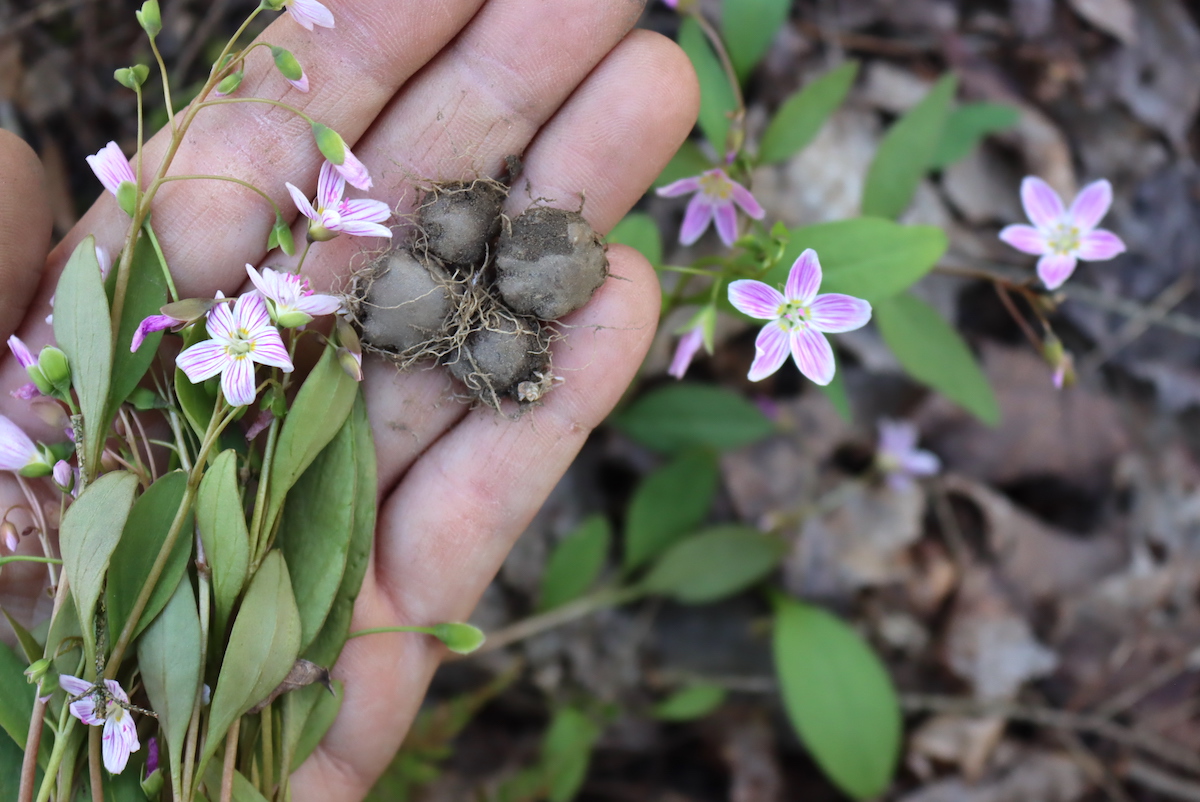
Spring beauty is a tiny yet stunning wildflower that carpets the forest floor each spring. It can be difficult to find, but that’s not because it’s rare or threatened. It is, in fact, incredibly common.
The thing is, it’s what’s known as a “spring ephemeral,” which means it spends all but a few weeks hiding beneath the soil. Each spring, the leaves, stems and blossoms will emerge for just a few short weeks to soak up sunlight before the trees leaf in above, closing the canopy.
Once they’re in full shade, they’ll pull their nutrient reserves back beneath the soil and wait patiently until next year.
That’s their plan, year after year, hiding all but a few weeks beneath the leaf litter. In that way, they’re able to make use of woodland space in the short window after snow melts but before the trees leaf in above.
Wild leeks (ramps) have the same strategy, and they’re equally common…it’s more about knowing when to look than where.

Is Spring Beauty Threatened or Endangered?
Spring beauty is not threatened or endangered, and it’s not at risk of overharvesting. It is incredibly common and widely distributed.
Many foraging guides will tell you specifically not to harvest spring beauty simply because “It’s a beautiful wildflower.” That leads to the incorrect assumption that these plants are threatened or endangered in some way, which is not the case.
The tiny flowers are beautiful each spring if you take the time to walk the woods and notice them during their short season. The flowers are very striking, with their bright pink stripes and miniature petals.
And a name like spring beauty is good marketing. Plants like Marsh Marigold are equally beautiful (in my opinion) but commonly foraged…perhaps because they don’t have the same PR firm. Anything with “marsh” in the name doesn’t need special protection.
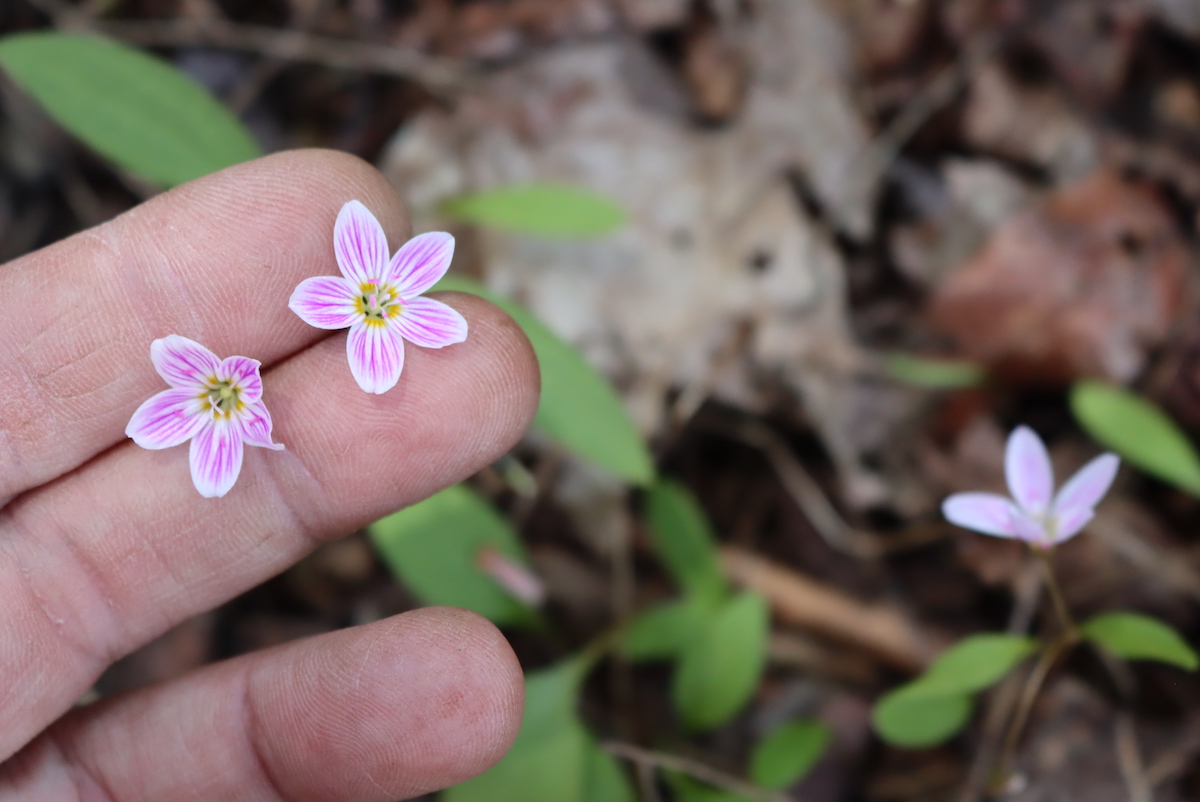
Sam Thayer puts it eloquently in his book, The Forager’s Harvest:
“There are many who say that we should not eat spring beauty because it is such a beautiful wildflower. They are right about one thing: it is quite pretty. But I’m not yet convinced that there is any merit in limiting my diet to ugly things. If that were the case, I wouldn’t be foraging at all, as there is not a single wild plant that I find unattractive. And while I must admit that subjectively some plants do really please the eye more than others, spring beauty (no disrespect intended) is not near the top of my list…
Spring beauty is an abundant plant in much of eastern North America. In the woods where I live, if you blindly toss a hula hoop, it would land encircling a spring beauty plant nearly every time. The plant abounds over millions of acres in Wisconsin alone, and it’s not unusually common here.”
When you harvest the leaves or flowers, the plant will just grow back without issue the following year. That’s the most sustainable way to harvest, and, honestly, some of the most worthwhile parts of the plant. Spring beauty leaves are excellent spring salad greens.
Be aware that harvesting the roots does kill the plant, but that’s so labor-intensive for a small number of calories that it’s unlikely that many people will harvest more than a few for novelty’s sake. It takes about an hour to harvest a cup of roots, and a full day of harvesting would barely dent an average-sized patch (and send you home with less calories than you spent digging them).
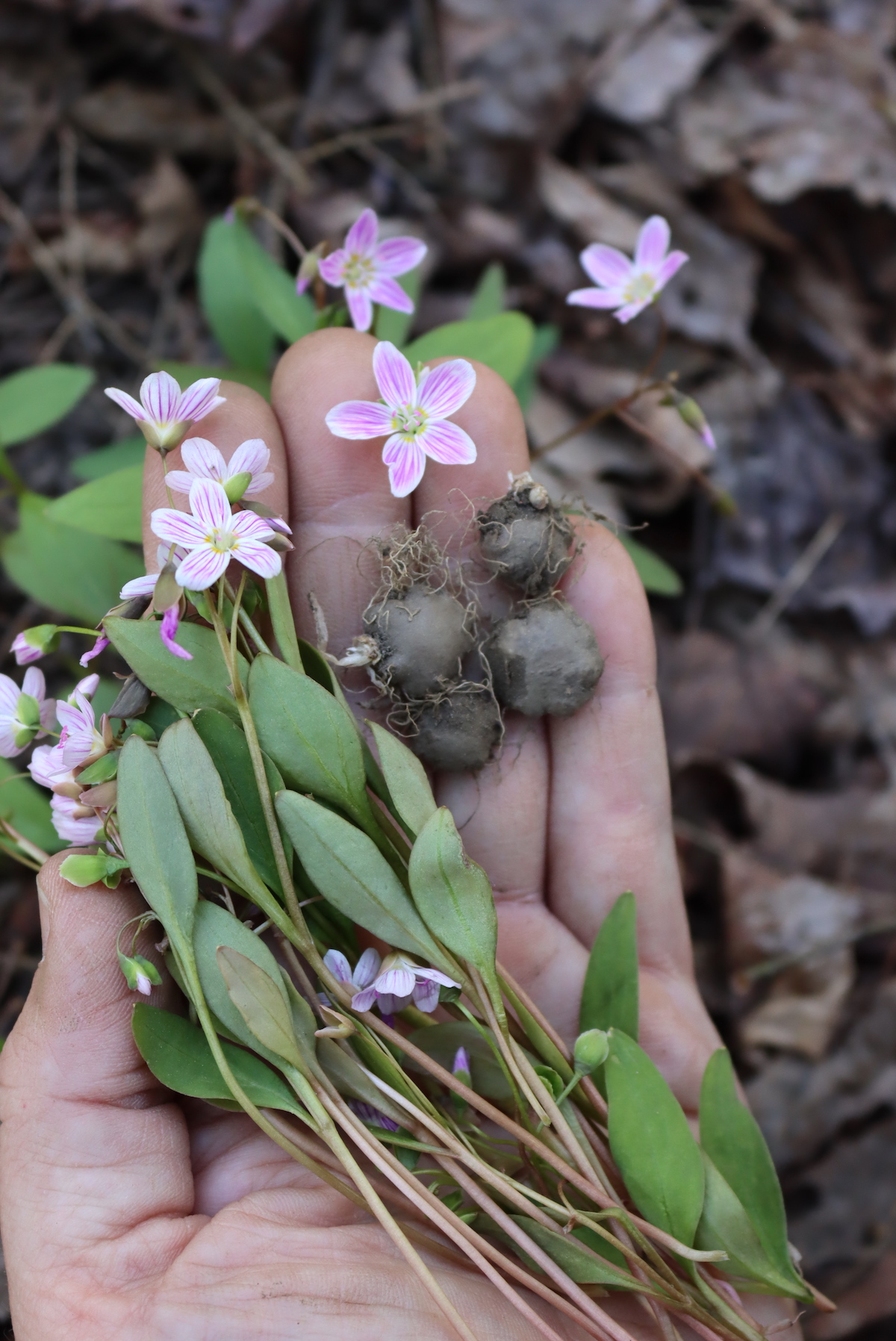
Where Does Spring Beauty Grow?
Spring beauty is often found in rich, moist woodlands with deciduous trees in the canopy. This particular patch was surrounded by other spring ephemerals, namley: Bloodroot, wild ginger, blue cohosh, leatherwood, Canadian Mayflower, trout lilly, and trillium.
Arthur Haines notes that they’re “most frequently on high terrace river floodplains near the base of rocky slopes where trees such as sugar maple (Acer saccharum), American linden (Tilia americana) and white ash (Fraxinus americana) are common. Common herbs this species frows with include blue cohosh (Caulophyllum thalictroides), American trout lily (Erythronium americanum), and bloodroot (Sanguinaria canadensis).”
He’s speaking specifically of C. caroliniana.
Sam Thayer says they’re “strongly associated with other mesic forest plants such as toothwort, jack-in-the-pulpit, maidenhair fern, blue cohosh, trout lily, wild leek, and dutchman’s breeches.”
If you can locate the type of woodland they tend to grow in, there’s a good chance you can find spring beauty, provided you’re there at the right time.
The best time to find them is in the early spring, around the time you see dandelion greens…but before dandelion blossoms. Here in Vermont, that’s usually around may 5th to 10th, and we’ll see our first dandelion blossoms around May 15th. Further south, you’ll find them in March and April.
Ask around in your local foraging groups, or keep an eye out for wild leeks in the woods (which are found in many of the same spots), or you can sometimes spot ramps at the farmer’s market in season if it’s well stocked. When you see them, it’s spring beauty season.
Various species can be found across all 50 states and up into Canada and into the arctic, though they’re most commonly associated with the northern half of the US.
Spring Beauty Edible?
All parts of spring beauty are edible, from the tiny delicate flowers with a mildly sweet flavor, to the delicate succulent leaves that are incredibly prized salad greens.
Below the soil, you’ll find tiny tubers where the plant stores it’s energy reserves until the following year. These are delicious as well, and when washed and boiled, they taste like tiny fairy potatoes.
Know that harvesting the tubers kills the plant, and given that they’re about the size of a pea, you’ll need to harvest a lot of tubers to have more than a spoonful of food. They’re more of a novelty, unless you’re a devoted forager that’s going to put a lot of time into digging spring beauty “potatoes.”
(For the botanically specific, the “tubers” aren’t technically tubers, they’re actually tap roots (like carrots) that just happen to have a round shape, but that’s a technical thing.)
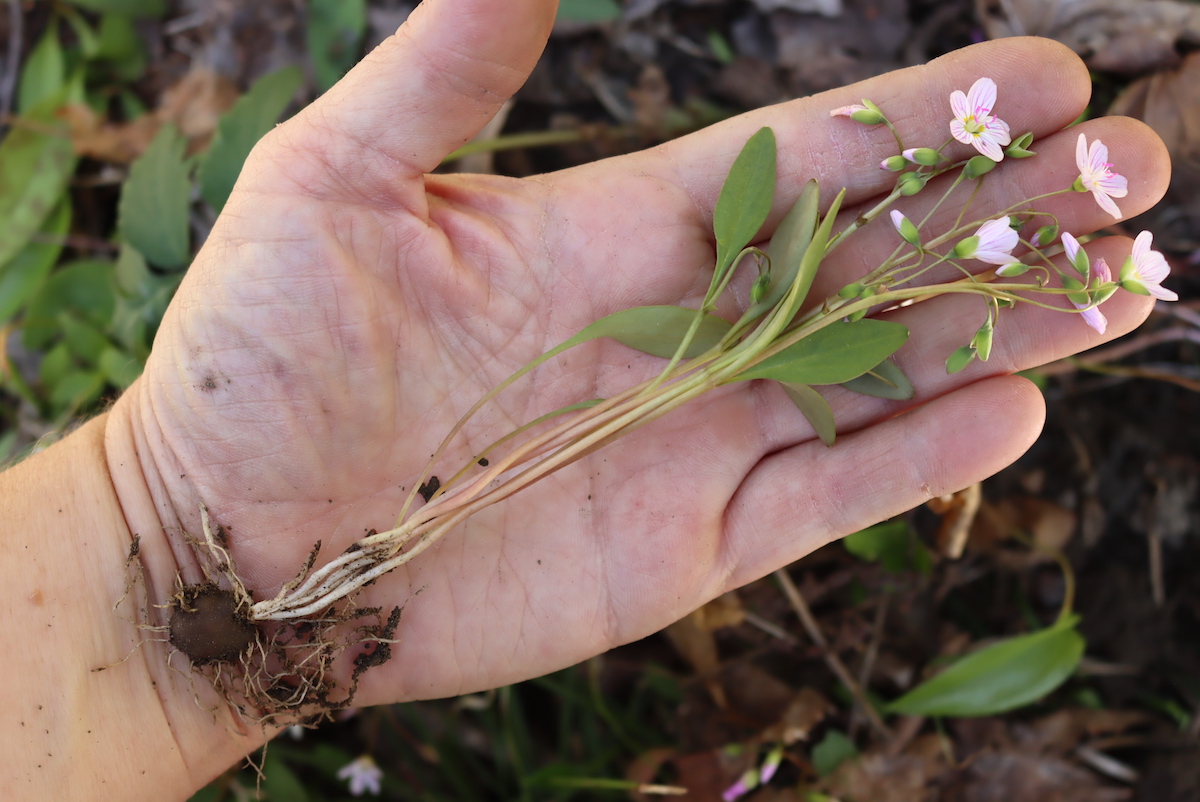
Identifying Spring Beauty
Few things look like spring beauty, so it’s a relatively safe plant to forage in the woodland. Often, it can be difficult to distinguish between specific types of spring beauty, but they’re all edible.
The most common type is Claytonia virginicana, but you’ll also find C. caroliniana, which looks very similar. Out west, they have C. nevadensis, and in Alaska they have C. acutifolia and C. tuberosa. They’re all quite similar, and all delicious.
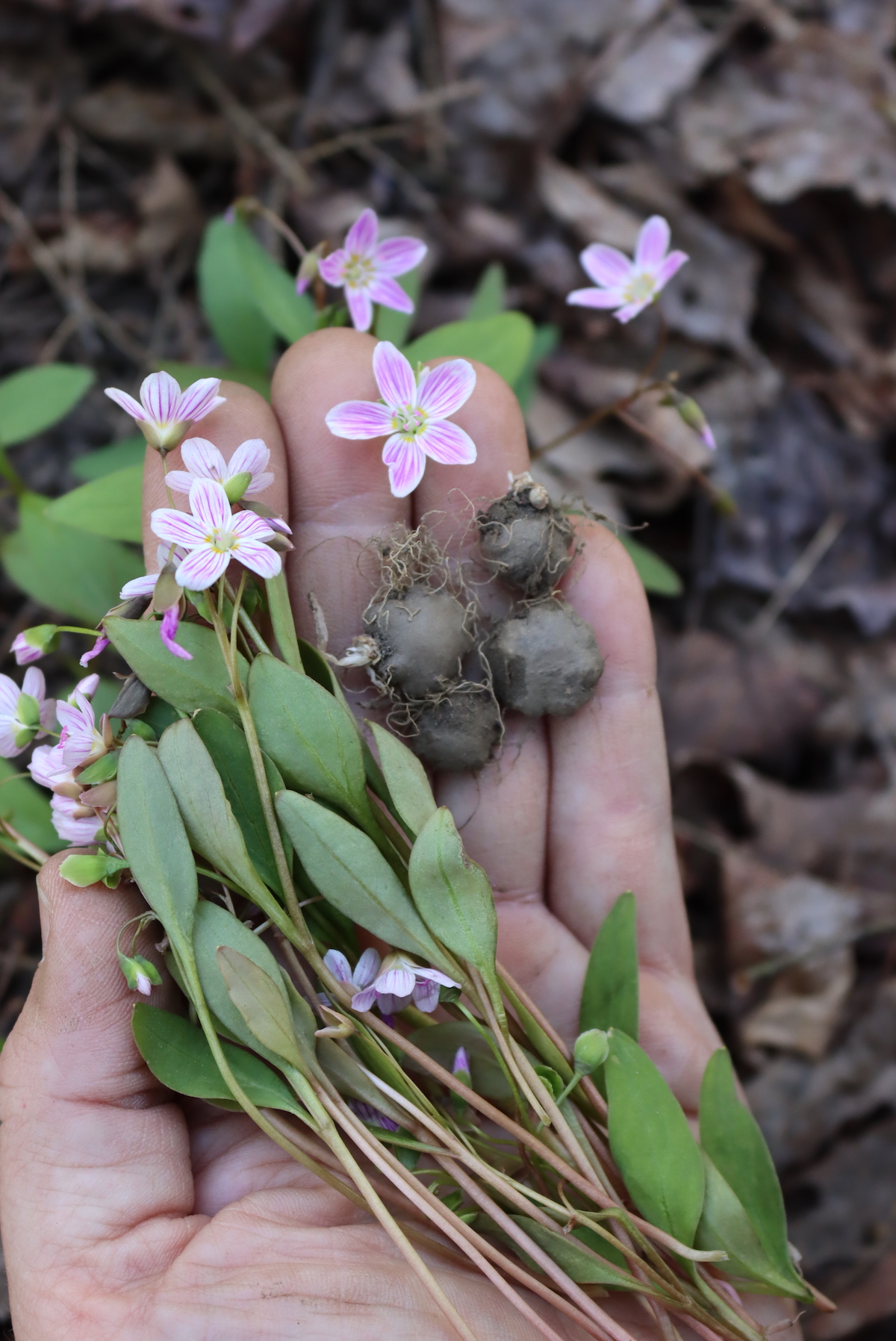
Spring Beauty Flowers
The first thing you’ll notice about spring beauty, if you happen to find it in season, is the beautiful tiny flowers.
They have 5 petals, that are white or light pink, with darker pink veins. Each is small, ranging from 1/2 inch to 3/4 inch across (a bit over 1 cm to just under 2 cm).
Spring beauty blossoms only open when it’s sunny, and they naturally turn to face the sun. You usually find them in clusters, as each plant sends up many stems and produces many flowers at once. Since they grow in colonies, you’ll see many little clumps of flowers carpeting the forest floor.
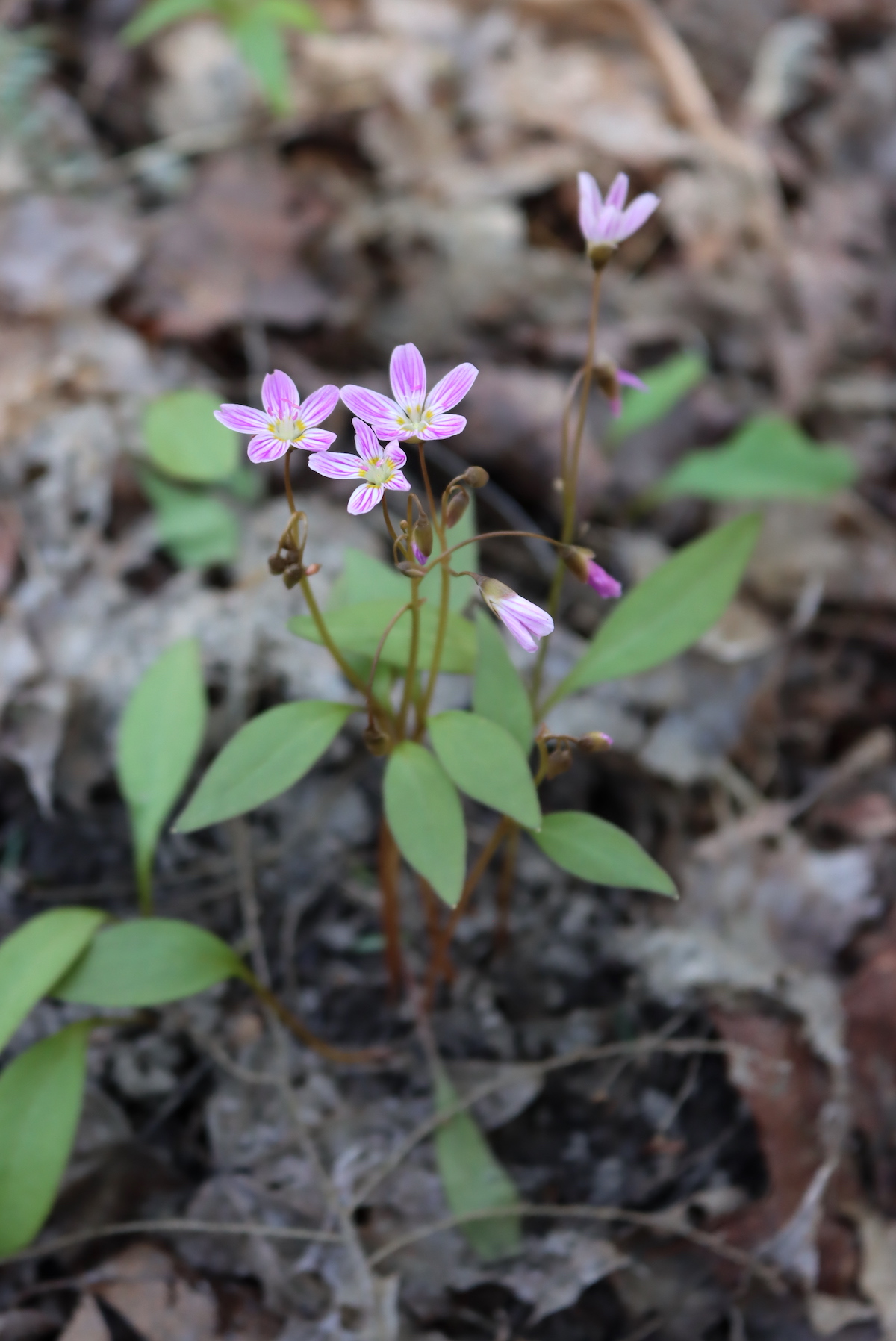
Spring Beauty Leaves
The leaves of spring beauty can vary by species, and some are wider than others. Some species have long and narrow leaves, and others have wider leaves. Generally, they’re described as “lanceolate,” which means a long oval with a bit of a point at each end.
They’ve got a delicate, but crunchy texture that’s best described as succulent. Soft, but with a rich, juicy crunch, kind of like a cucumber.
Spring Beauty Stems
Since spring beauty grows with multiple stems from a single tuber-like root, you’ll always find them coming up in tiny clusters.
If you want to harvest the root, you’ll need to follow each cluster of stems down to where it meets the earth.
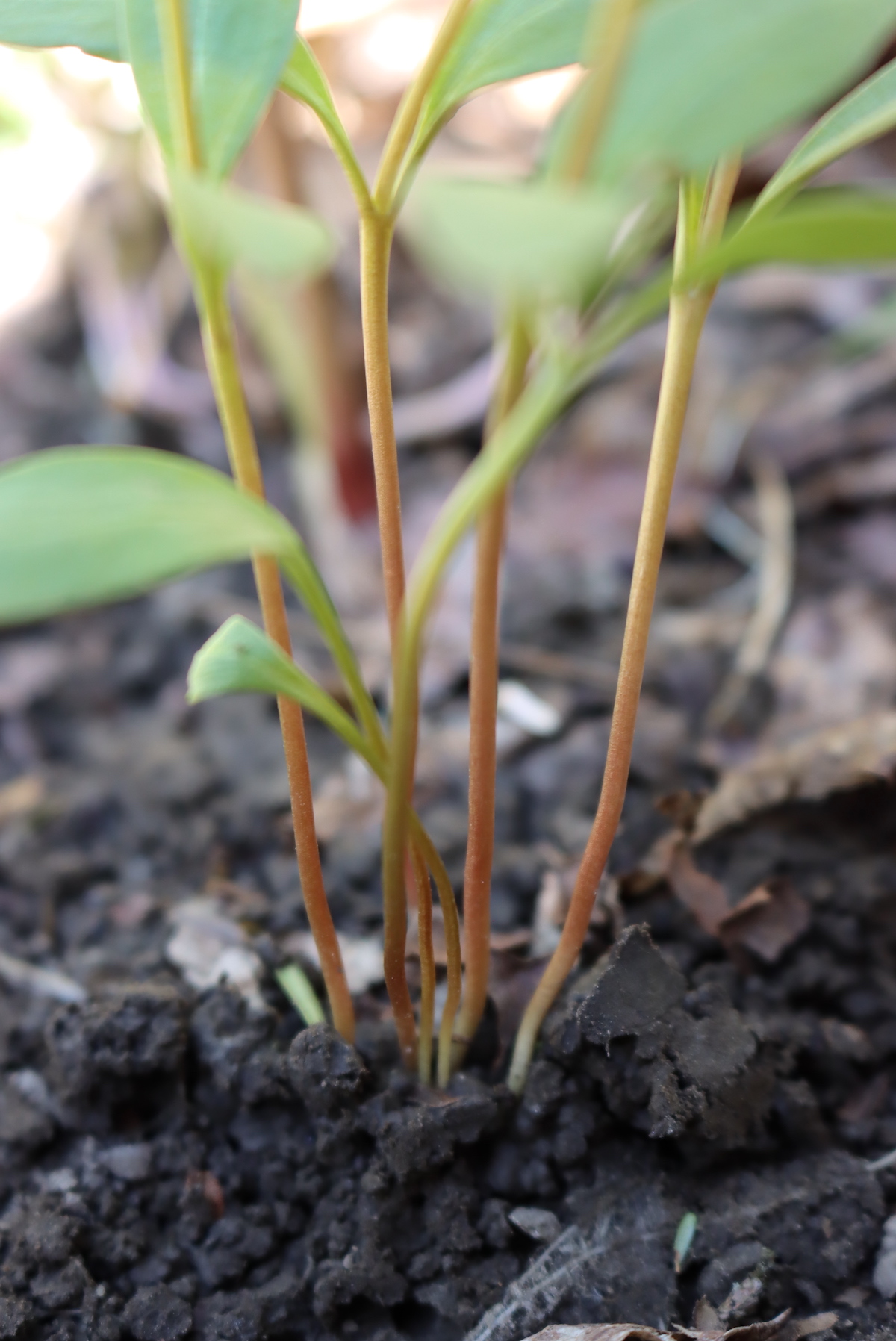
Spring Beauty Roots
The stems of spring beauty go beneath the soil as a cluster, and they’ll join together at the top of the “fairy potato” or tiny edible spring beauty root. The roots themselves are usually about 2 to 4 inches below the soil, so be prepared do dig a bit for each one.
Larger clusters of stems tend to have larger roots, but none are all that big. Expect roots that are about the same size as the flowers, roughly 1/2 to 3/4 of an inch each. In some cases, the roots can be as large as 1 1/2 inches, but that’s about as big as they get.
Each one is lenticular, which means like a flattened circle, thickest in the middle and tapering towards the sides.
As I’ve mentioned already, they’re technically “tap roots,” but they look more like potato tubers to most people.
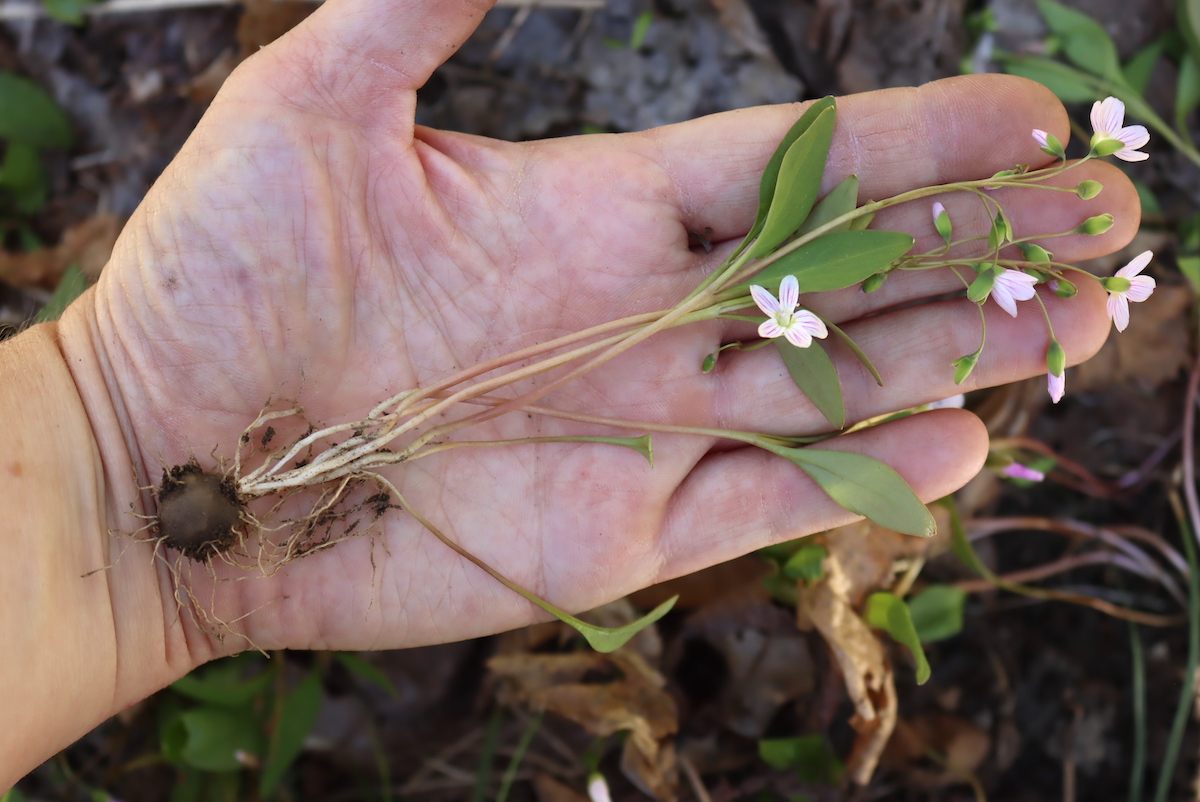
Spring Beauty Look-Alikes
To my eye, nothing really looks like spring beauty, especially in flower. Some species of wood sorrel have similar flowers, but very different leaves. They’re also edible, but have a distinctive lemon-y taste.
I’ve read that some people think that herb robert and Canadian mayflower look similar.
Herb robert has feathery leaves, but it does have small pink flowers. Either way, it’s edible.
Canadian mayflower has very different flowers, tiny white stalks of multiple very tiny white flowers, but it does have similar leaves. It’s also considered edible, or at least not toxic, though some people have a reaction to it.
Spring Beauty Recipes
So how do you eat spring beauty?
For the most part, the leaves and flowers are eaten raw in the field, or brought home for use in a salad. They’re quite sweet and succulent, unlike other spring greens that tend to be bitter. They’d go well as the base for a salad that incorporated a lot of other wild spring greens (like dandelion, etc).
As to the tiny tubers, they’re sadly just a novelty because of all the labor involved in collecting them. They are delicious, but you’ll spend all day collecting enough for a side dish for a small gathering.
As to flavor and uses, they’re tasty, and can be eaten raw or cooked. Cleaning them takes some work, but if you work them with your fingers under running water they’ll get pretty clean (and they peel that way too).
Sam Thayer notes,
“Fairy spuds are somewhat potato-like, but softer and very mildly sweet. Just boiled, they are wonderful – far superior to potatoes, in my opinion. Unlike potatoes, these roots are soft and pleasant raw as well. However, eating them raw sometimes leaves an unpleasant scratchy feeling in the back of my throat.”
This is a good point to note, as everyone reacts differently to new foods, and you should always eat just a small amount to see if you have a reaction. It’s always possible to have an allergy or reaction to a new food, even those that are generally considered safe and edible.
Spring Foraging
Spring beauty is just one of many things you can forage in the springtime…
- Foraging Morel Mushrooms
- Foraging Pheasant Back Mushrooms
- Foraging Ramps (Wild Leeks)
- Foraging Fiddlehead Ferns
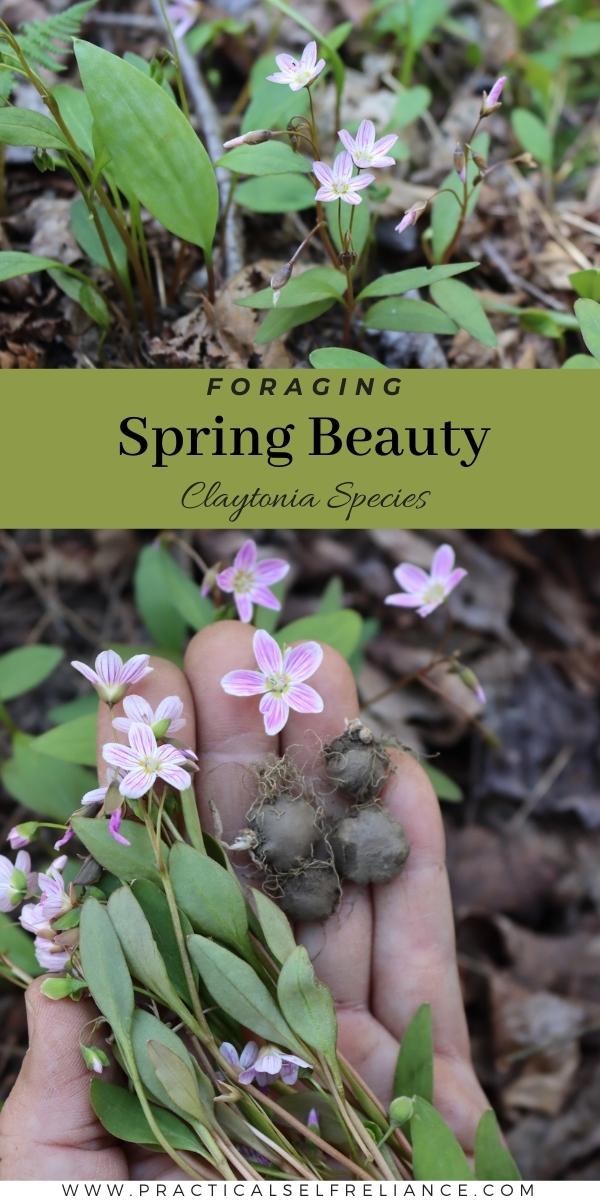
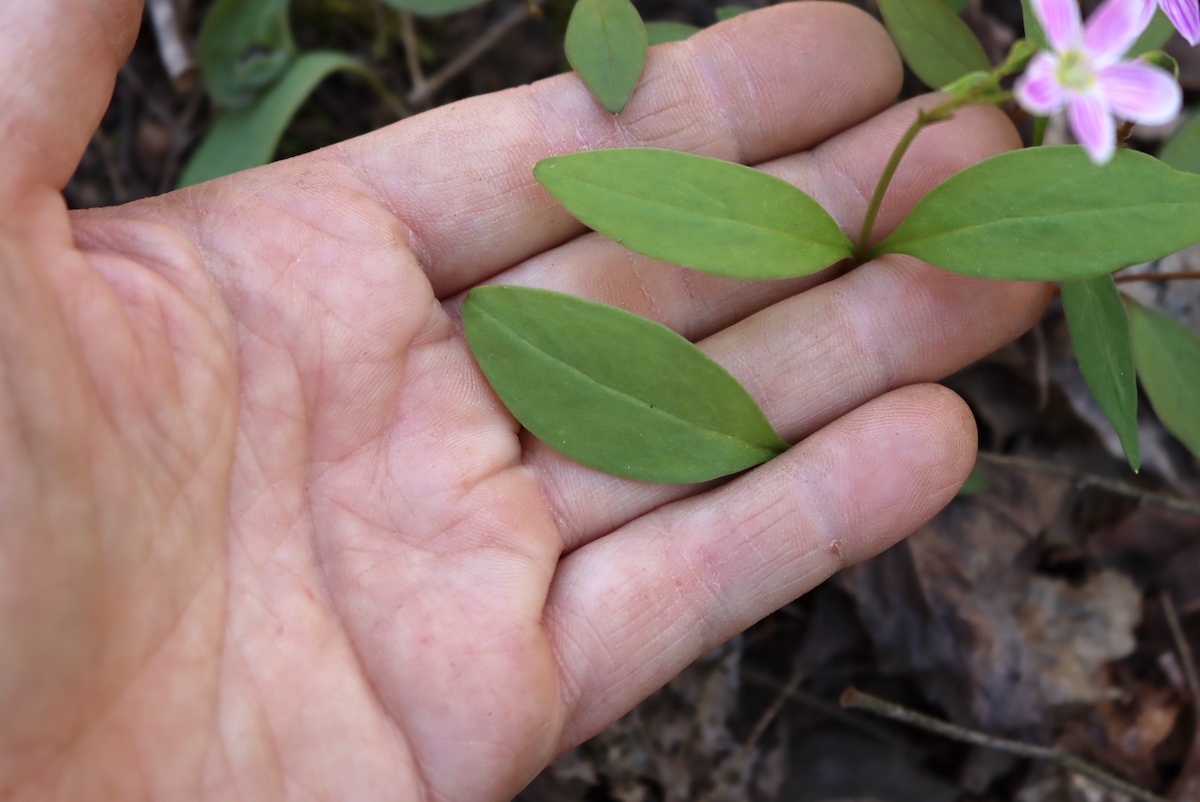



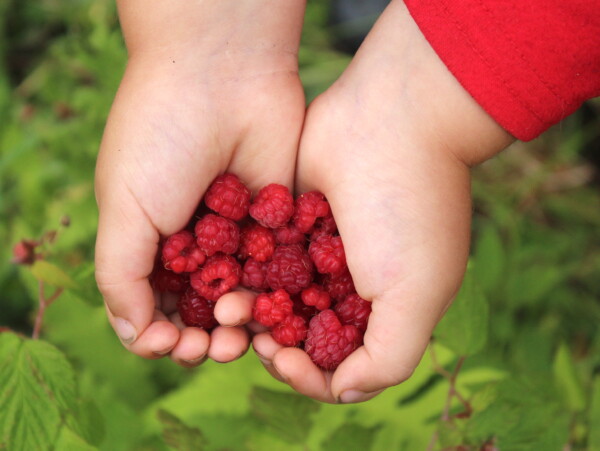
My kids and I had no idea what these were until we used our wildflower field guide to break them down by color, flower type, and leaf type. Voila, they were Spring Beauty! This is our first spring on this property and its sort of been like Christmas morning every day – so many surprises. We also discovered some kind of wild rue, four pink petals that look a lot like a wild rose but super flat. Never seen that either!
Thanks for the great article, as always.
Nice Tessa! I’m so happy for you. Spring beauty is a real treasure, and tasty. A small treat, but still worth it in my book.